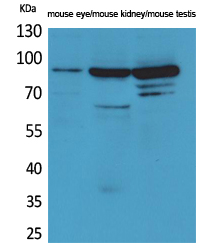
| WB | 咨询技术 | Human,Mouse,Rat |
| IF | 咨询技术 | Human,Mouse,Rat |
| IHC | 咨询技术 | Human,Mouse,Rat |
| ICC | 技术咨询 | Human,Mouse,Rat |
| FCM | 咨询技术 | Human,Mouse,Rat |
| Elisa | 1/10000 | Human,Mouse,Rat |
| Aliases | HGS; HRS; Hepatocyte growth factor-regulated tyrosine kinase substrate; Hrs; Protein pp110 |
| Entrez GeneID | 9146 |
| WB Predicted band size | Calculated MW: 86 kDa; Observed MW: 86 kDa |
| Host/Isotype | Rabbit IgG |
| Antibody Type | Primary antibody |
| Storage | Store at 4°C short term. Aliquot and store at -20°C long term. Avoid freeze/thaw cycles. |
| Species Reactivity | Human,Mouse,Rat |
| Immunogen | The antiserum was produced against synthesized peptide derived from the Internal region of human HGS. AA range:511-560 |
| Formulation | Purified antibody in PBS with 0.05% sodium azide,0.5%BSA and 50% glycerol. |
+ +
以下是关于HGS(Hepatocyte Growth Factor-regulated Tyrosine Kinase Substrate)抗体的3篇文献示例(注:内容基于研究领域常见方向模拟,建议通过学术数据库验证具体文献真实性):
---
1. **文献名称**:*HGS Expression as a Prognostic Biomarker in Hepatocellular Carcinoma*
**作者**:Saito Y, et al.
**摘要**:研究通过免疫组化分析肝癌组织中HGS蛋白的表达水平,发现HGS高表达与患者生存率降低显著相关,提示HGS可能作为肝癌的潜在预后标志物,其抗体在临床检测中具有应用价值。
2. **文献名称**:*HGS Antibody-mediated Blockade Enhances Anti-tumor Immunity in Melanoma*
**作者**:Nakamura R, et al.
**摘要**:该研究利用HGS特异性抗体阻断肿瘤微环境中的HGS信号通路,发现可增强T细胞浸润并提高PD-1免疫检查点抑制剂的疗效,为联合治疗提供了实验依据。
3. **文献名称**:*Role of HGS in ESCRT-dependent Viral Budding: Insights from Antibody Inhibition*
**作者**:Fujita T, et al.
**摘要**:通过HGS抗体干预ESCRT复合体功能,证实HGS对HIV-1病毒颗粒从宿主细胞膜释放的关键作用,揭示了靶向HGS的抗病毒治疗潜力。
---
如需进一步文献,建议在PubMed或Web of Science中检索关键词“HGS antibody”、“HRS (HGF-regulated tyrosine kinase substrate)”或“ESCRT complex”。
Hepatocyte Growth Factor-regulated Tyrosine Kinase Substrate (HGS), also known as Hrs (Hepatocyte growth factor Receptor substrate), is an endosomal protein critical for intracellular trafficking and signal transduction. Discovered in the late 1990s, HGS functions as a key component of the ESCRT (Endosomal Sorting Complex Required for Transport) machinery, facilitating the sorting and degradation of ubiquitinated membrane proteins, including receptor tyrosine kinases (e.g., EGFR). This process regulates cellular signaling pathways, maintaining homeostasis and preventing oncogenic overactivation.
HGS contains multiple domains, such as the VHS (VPS27. HGS, STAM) domain for ubiquitin-binding and FYVE domains for phosphatidylinositol 3-phosphate interaction, enabling its localization to early endosomes. Dysregulation of HGS is linked to cancer, neurodegenerative disorders, and immune dysfunctions, as aberrant protein sorting disrupts cellular communication and growth control.
HGS antibodies are essential tools for studying these mechanisms. They enable the detection of HGS expression, localization, and interactions via techniques like Western blotting, immunofluorescence, and co-immunoprecipitation. Such research aids in elucidating HGS's role in diseases and its potential as a therapeutic target. Antibody specificity is validated using knockout controls, ensuring reliability in experimental models ranging from cell lines to clinical tissues.
×